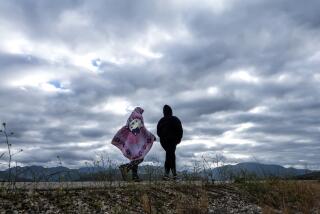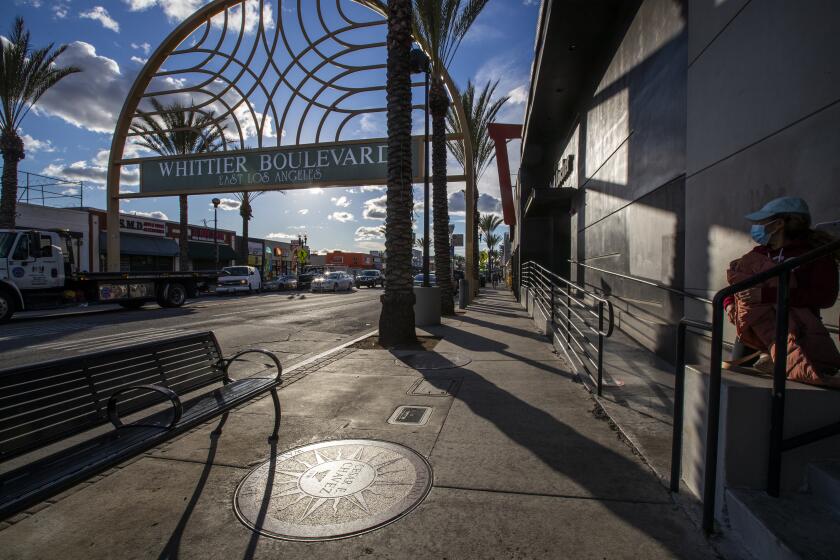Hopes Dim for LAMP Skid Row Program
The public showers at LAMP Village are empty, the linen service and convenience store still--the signs of crisis at a skid row institution.
After years of barely getting by financially, LAMP has laid off more than half its employees and closed some of its most cherished enterprises while it contemplates the future of the village.
Faced with a $100,000 deficit, LAMP announced last month that it would have to close the village, a 48-bed residential facility that plays a key role in the organization’s three-pronged program for the mentally ill homeless.
The news stunned the skid row care community and sent Los Angeles County mental health officials scurrying to help a nonprofit agency known for its innovative approaches in dealing with mentally ill street people.
“They are such a beacon in the community as far as progressive treatment and provision of services,” said Perri Johnson, assistant director of the county’s Skid Row Mental Health Center. “They really kind of revolutionized the concept of what work means for persons with mental illness.”
Discussions with the county have left LAMP officials hopeful that they can obtain enough additional funding to keep the village open and revive some of the businesses, which employed LAMP clients at minimum wage jobs.
But much of the potential bailout--which would take the form of expanded service contracts and grants--would not be available until the new fiscal year this summer, leaving LAMP in the grip of debt for the time being, trying to hold creditors at bay.
Moreover, while they offer support, county officials and others want LAMP to get its fiscal house in order.
“We also have to be assured that their management is . . . not going to be in the same problem a year from now,” said county mental health Director Areta Crowell.
A manager with another skid row organization said that while LAMP’s advocacy work was well regarded, “there’s a lot of concern about LAMP’s ability to manage their resources . . . at least competently.”
LAMP officials, who get much of their $1.2-million annual budget from government sources, attribute their fiscal troubles to two factors.
They have, until now, resisted shutting their two big money losers, a commercial linen service and convenience store, because they provided jobs LAMP considered critical to helping residents stabilize and cope with their problems.
Moreover, LAMP executives say their cause does not have the kind of warm and fuzzy appeal that attracts big donors.
“We’re not cute, and people don’t want to give us money,” said LAMP Executive Director Yvonne Williams, who succeeded Mollie Lowery at the agency’s helm.
Lowery, who left in late 1994 for a quieter life in Bishop, Calif., after nearly a decade of running LAMP, has returned on a consulting basis in recent months to write grant proposals and develop new funding sources.
“The family is having trouble now, and it’s mostly fiscal,” she said, clearly uncomfortable at discussing the financial troubles of an agency she helped build into one of the most respected on skid row.
Even if the village closed, LAMP has said it could accommodate the 36 men and women now living there at its two other downtown facilities, a drop-in center that has temporary beds, and the lodge, a 50-unit apartment building.
But life elsewhere would clearly not be the same as it is in the Crocker Street village.
A former city garage turned into an airy brick refuge of dorms and community rooms, the village is run as a transitional facility that offers more services than the apartment house and more permanency than the drop-in center.
Some village residents like it so much they have lived there for years.
“I have a problem with isolation,” Marc, 53, said, explaining why he has not moved into LAMP’s apartment building after two years in the village.
The former machinist from Michigan was sitting on his bed in the men’s dorm, listening to classical music and surrounded by carefully tended potted plants. Each person has an individual cubicle equipped with storage and electrical outlets, affording a bit of personal space without the isolation he so dreads.
The village asks for $200 a month from those who can pay it, and along with housing, gives residents three meals a day, activities, substance abuse recovery groups and, until recently, jobs for those capable of performing them. Residents worked part time, folding laundry and loading washers in the linen service, which provided bedding and towels for skid row hotels, and helped out in the other village enterprises: a coin laundry, convenience store, showers and toilets for the skid row public.
More to Read
Start your day right
Sign up for Essential California for news, features and recommendations from the L.A. Times and beyond in your inbox six days a week.
You may occasionally receive promotional content from the Los Angeles Times.






